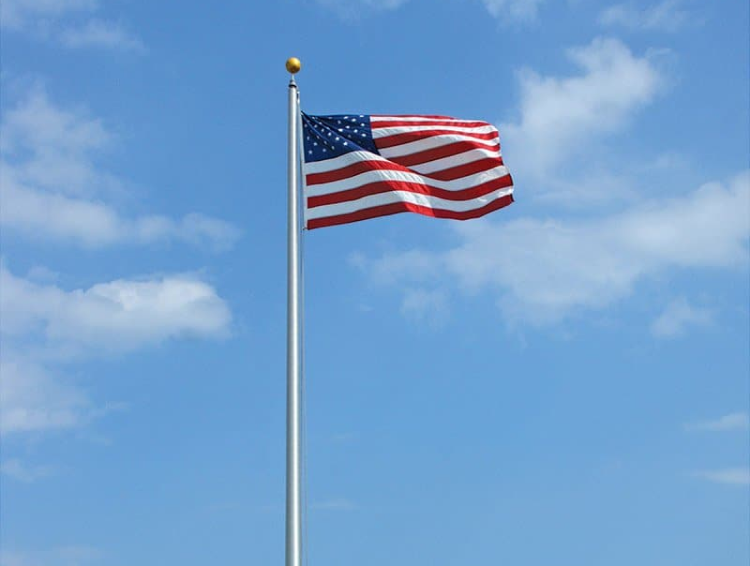Your Cart is Empty
How to Choose a Location for a Flagpole
4 min read
You’re about to make an important addition to your home or place of business—you’ve decided to display your pride and patriotism by flying the American flag. But there’s more to hoisting the flag than simply saying you’re going to do it. You need to make sure your flagpole is of appropriate height, placement, and integrity. Wherever you’re planting your flag, here are the top tips for choosing an ideal flagpole location
Flagpole Placement: What you need to know
In this article we explore key factors around flagpole placement, including flag visibility, local regulations, wind direction, and aesthetics to ensure your flag flies proudly in the best spot for your home or business. Choosing the ideal location for your flagpole involves careful consideration and taking the right steps will help to avoid any issues further down the line.
1- Just-right height
Finding the right height for your flagpole can have you feeling a little like Goldilocks—you want one that’s not too tall nor too short but just right. A flagpole that comes up short can look inconsequential, and a flag that doesn’t get far enough off the ground can appear out of proportion. On the other hand, a flag that towers over your trees can be a distraction and may even violate your local ordinances.
For houses, a good rule of thumb for choosing a flagpole is that the top of your flagpole should not climb above the highest point of your roof. By keeping it in harmony this way, the pole won’t dwarf your house nor look insignificant. Businesses on busy roads can explore taller flagpoles as a way to draw extra attention, but they may need to confirm that such heights are compliant with local ordinances.
Ultimately, the size of the flag will influence the height and size of the flagpole required, which, in turn, affects the available placement options. So it is important to determine the flag size you plan to fly before finding its suitable placement location.
2 - Ensure a good flagpole foundation
Whether you’re building a house or installing a flagpole, a solid foundation is key. Make sure your flagpole can accommodate going at least two feet underground for maximum stability. However, as any homeowner knows, digging a hole two feet deep is rarely as simple as saying you’ll do it and grabbing the shovel.
Consult with your local utilities to make sure the location you’ve selected will not interfere with any underground power, water, or telecom lines. This small precaution can save you from doing massive damage to your property and even your entire neighborhood. Make sure to reinforce your hole—generally four times the diameter of the pole—with quality concrete.
3 - Check the visibility
Before committing to a location for your flagpole, you’ll need to ensure the area of your property offers maximum visibility and is not obstructed by trees or power lines. If you are installing a residential flagpole, an ideal location would be the front yard, near the driveway, or close to the front entrance where the flag can be easily seen by neighbors and passersby. Especially near a window or a room where you can enjoy the view from inside. For commercial flagpoles, you will need to locate areas that are within close proximity to your business property to help reinforce your brand’s identity. Such as main entrances or high-traffic areas.
4 - Consider main wind direction
Be sure to check the main wind direction of your home or business property to ensure your flag can fly freely without being obstructed by trees, signs or power lines interfering with your flags movement. If your area is particularly exposed to harsh weather conditions, you may need to check that your flagpole is engineered to withstand it.
6 - Buy a quality flagpole
The most important of all the top tips is to choose a flagpole that's built to last. A high-quality American flag is important, but it’s nothing without a matching high-quality flagpole. Remember that your pole needs to be able to withstand rain, snow, and high winds.
A cheap metal bar or tube that you’ve repurposed into an ad-hoc flagpole may make you feel like you’ve saved a couple of bucks, but when it gets bent or goes down in a storm, the money you saved won’t cover your embarrassment. Not to mention the damage an errant 20-foot pole could do to your home, business or your neighbor’s property.
Now you've picked your location, learn how to install your flagpole.
Federal Flags isn’t just a flag store; it’s a flagpole store, too. Our selection of purpose-built, wind-test-certified flagpoles ranging from 15 to 80 feet will ensure your flag flies at its proudest and most secure. Speak with our expert team to discuss your residential and commercial flagpole needs today and we will help you find the right one.
Or, if you just need support with installing your flagpole, check out our professional guide here with all the tips you’ll need.
Also in Federal Flags Resources
Shop our Flagpoles & Flags
Subscribe
Sign up to get the latest on sales, new releases and more …







